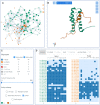RING 3.0: fast generation of probabilistic residue interaction networks from structural ensembles
- PMID: 35554554
- PMCID: PMC9252747
- DOI: 10.1093/nar/gkac365
RING 3.0: fast generation of probabilistic residue interaction networks from structural ensembles
Abstract
Residue interaction networks (RINs) are used to represent residue contacts in protein structures. Thanks to the advances in network theory, RINs have been proved effective as an alternative to coordinate data in the analysis of complex systems. The RING server calculates high quality and reliable non-covalent molecular interactions based on geometrical parameters. Here, we present the new RING 3.0 version extending the previous functionality in several ways. The underlying software library has been re-engineered to improve speed by an order of magnitude. RING now also supports the mmCIF format and provides typed interactions for the entire PDB chemical component dictionary, including nucleic acids. Moreover, RING now employs probabilistic graphs, where multiple conformations (e.g. NMR or molecular dynamics ensembles) are mapped as weighted edges, opening up new ways to analyze structural data. The web interface has been expanded to include a simultaneous view of the RIN alongside a structure viewer, with both synchronized and clickable. Contact evolution across models (or time) is displayed as a heatmap and can help in the discovery of correlating interaction patterns. The web server, together with an extensive help and tutorial, is available from URL: https://ring.biocomputingup.it/.
© The Author(s) 2022. Published by Oxford University Press on behalf of Nucleic Acids Research.
Figures



References
-
- Dill K.A., MacCallum J.L.. The protein-folding problem, 50 years on. Science. 2012; 338:1042–1046. - PubMed
Publication types
MeSH terms
Substances
LinkOut - more resources
Full Text Sources
Molecular Biology Databases

